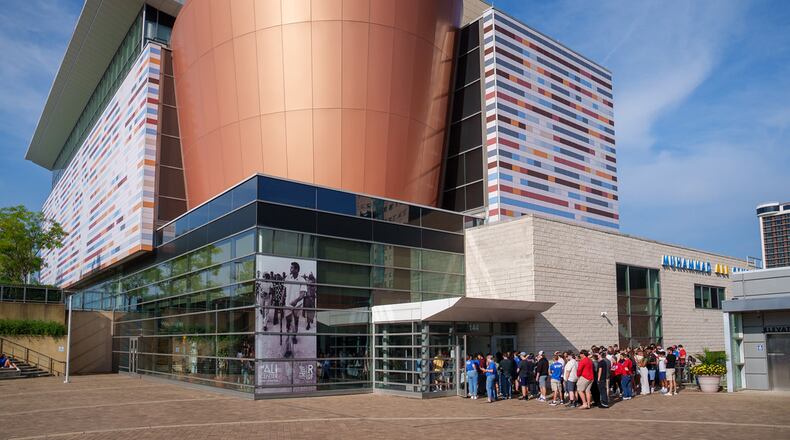“I think a lot of people approach the center because they know Muhammad as the greatest of all time, the three time heavyweight champion boxer. But they leave understanding that he was so much more than that.” said the museum’s senior marketing manager Annie Moore. “Boxing was just a platform that he used to create the real change that he believed was his life’s work.”
Opening in November 2005, the Muhammad Ali Center was 20 years in making. Its development was spearheaded by Ali and his wife Lonnie, who wanted a place to not only celebrate his career and life, but also to promote peace and mediation.
“There’s been so much work involved in getting this project not only off the ground, but showing the concept and making people believe in the mission.” said Lonnie Ali in a New York Times article covering the museum’s opening that year. “Then to get to the point now where the building is there, the programming is there, the exhibits are there is amazing. It’s a dream come true.”
The center offers various exhibits covering different aspects of Ali’s legacy.
“The Path of a Champion” is an area where guests can walk through a timeline of Ali’s 56-5 boxing career. Filled with artifacts and memorabilia from his life, visitors can see how he earned his title of “The Greatest.” This exhibit also features a short film narrated by Samuel L. Jackson.
Credit: LouisvillePhotographer.com
Credit: LouisvillePhotographer.com
Guests can view screenings of the boxer’s most famous bouts in the “All Ali, All the time” exhibit and learn about his journey as a torchbearer in the 1996 Olympics at the “Global Showstopper” area.
Visitors can also step into a recreation of Muhammad Ali’s training camp in the “Step into the Ring” exhibit. There, guests can play a variety of boxing-themed games including shadow boxing and rhythm training.
Credit: LouisvillePhotographer.com
Credit: LouisvillePhotographer.com
“Beliefs That Shaped a Champion” is the exhibit exploring Ali’s spiritual journey and his various humanitarian acts. Moore emphasized this aspect of the museum, and said it exists to “foster social justice and inspire the next generation of peace makers.”
This exhibit is split across several pavilions, each themed to one of the six principle’s which shaped Ali’s life — confidence, spirituality, respect, dedication, giving and conviction.
The Confidence pavilion discusses the ways black Americans were inspired by Ali’s self-love and bravado during the Civil Rights Movement.
“It was kind of a radical act for a black man at that time to be very adamant and loud and proud about his own skills and appearance.” said Moore.
The Spirituality and Respect pavilions focus on Ali’s path of personal growth and tolerance for all peoples. These areas also explore his views on faith, including his conversion to Islam.
Credit: LouisvillePhotographer.com
Credit: LouisvillePhotographer.com
In the Dedication pavilion, visitors can learn about the boxer’s intense work ethic using videos and accounts from people who knew Ali.
“Muhammad said that the fight was lost or won far away from the ring.” said Moore. “He was dedicated to doing everything that he could to be as prepared as possible.”
Muhammad Ali’s acts of kindness and humanitarian efforts are explored in the Giving pavilion. Inside, guests can experience stories from Ali’s past, such as how he stopped a man from taking his own life and how he was crowned the United Nation’s “Messenger of Global Peace” in 1986.
The final pavilion, dedicated to conviction, tells the story of Ali’s activism during the Civil Rights era, focusing on his conscientious objection to the Vietnam War.
In 1967, Muhammad Ali was drafted into the United States Army. After refusing to be inducted as it conflicted with his faith, he was promptly arrested for draft evasion and stripped of his heavyweight titles. He was convicted in June 1967.
The ensuing legal battle lasted until 1971, where the Supreme Court reversed his conviction in Clay v. United States. During this time, Ali publicly expressed his anti-war views and refused to betray his morals.
Alongside the permanent installations, the Muhammad Ali Center also hosts limited-time events and exhibits.
Currently, the museum is home to an exhibition called “Portraits in Faith: Seeing the Other,” where guests can view photos of people from across the world. QR codes located next to portraits will play a video interview with each subject on visitor’s phone.
Credit: LouisvillePhotographer.com
Credit: LouisvillePhotographer.com
In March, the 11th annual "Shining a Light” photography exhibition will open, set to feature iconic women from various countries.
To celebrate Black History Month, the museum will host two events. On Feb. 18, a screening of “the Secrets of the Dead” episode “the Civil War’s Lost Massacre” will take place. This tells the story of the “Simpsonville Massacre,” where a battalion of black soldiers were ambushed and killed by outlaws.
On Feb. 27, the museum will host “Compassion in Action: The Journey to Greatness,” an event which will discuss how compassion is a foundational force for meaningful change. Various speakers will attend the event, including a panel of local leaders and the Muhammad Ali Compassion Report.
Later this year, the museum will celebrate its 20th anniversary. To commemorate the occasion, the center will host a special iteration of its annual Muhammad Ali Humanitarian Awards on Nov. 8.
HOW TO GO
What: Muhammad Ali Center
Hours: 10 a.m.-5 p.m. Wednesday through Sunday. Closed Monday and Tuesday. Admission closes at 4:15 p.m.
Location: 144 N. Sixth St., Louisville, Ky.
More info: alicenter.org
About the Author





